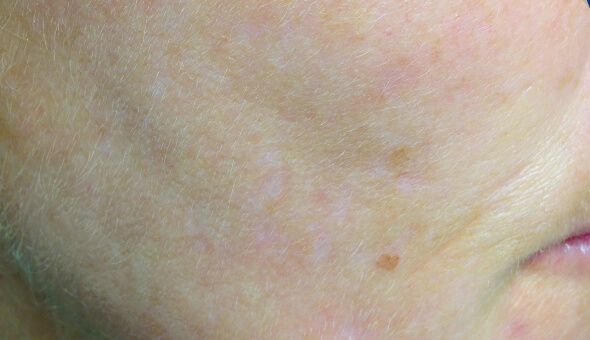We explain what facial peeling is, the main types available, its importance as a treatment and a few options for home use.

Our skin is constantly regenerating, although not always at the rate and intensity we would like. This regeneration is essential for our skin to not only look healthy but also to be healthy. We can facilitate this process by treating our skin with peeling or exfoliating products.
Skin ageing is more visible on the face than anywhere else on the body. That's why peeling treatments tend to focus on this area. But what do these treatments actually involve? We explain what facial peels are and the different types available, focusing on chemical facial peels.
What is a facial peel?
When we say peeling, we are actually referring to exfoliation, which encompasses the natural process of skin cell regeneration and a range of techniques designed to promote this process.
A facial peel is a dermatological and aesthetic treatment designed to improve the appearance of facial skin. These improvements, which are clear to see, are primarily due to the elimination of dead cells by helping them to slough off and make space for the generation of new skin cells.
Facial peeling is used to achieve positive cosmetic results for the following purposes:
- To obtain a smoother skin texture
- To improve skin elasticity and smoothness, resulting in a much more hydrated complexion
- To improve damage caused by photo-ageing
- To reduce expression lines and wrinkles
- To improve the appearance of scars, e.g. acne scars
- To correct blemishes and hyperpigmentation
- To improve some forms of keratosis
Types of facial peeling
There are numerous types of facial peels. There are two main groups: mechanical peels and chemical peels.
Mechanical peels
Mechanical peels involve the use of some physical abrasive or micro-abrasive material. These materials include microfibre cloths and sponges, adhesive sheets, thick gels (known as gommage) and solutions containing scrubbing granules (pumice, crystals, plastic microbeads or organic materials, etc.).
It is quite common to combine mechanical and chemical methods in the same product or treatment.
Chemical peels
As for chemical peels, which rely on the exfoliating capacity of the skin combined with one or more chemical substances or elements, there are different types of peels (from less to more intense) depending on the main active ingredient:
- Alpha-hydroxy acids (AHA): These are naturally occurring acids, such as glycolic acid and lactic acid. As they are small molecules, they penetrate deeper into the skin.
- Beta-hydroxy acids (BHA): Salicylic acid is the best-known type. These molecules, due to their liposoluble nature, have an affinity for sebum, making them perfect for improving the appearance of combination and oily skin. They help to control excess sebum.
- Jessner formula: This combination of resorcinol, lactic acid and salicylic acid is gentle. It is indicated for treating skin blemishes, uneven skin tone and ageing.
- Retinoic acid: Thanks to its greater penetration capacity, it is used by cosmetics professionals in combination with Jessner peels to reduce scars, blemishes and wrinkles.
- Trichloroacetic acid TCA: Capable of reaching the reticular dermis in high concentrations, TCA enables dermocosmetic professionals to perform a medium to deep peel, especially popular for phototype 4 skin.
- Phenol: Offering an an intense effect and deep penetration, it is only used by medical prescription to regenerate the dermal architecture.
Benefits of chemical facial peels
Today, dermocosmetic professionals predominantly use treatments based on chemical exfoliants (chemical peels) to restore skin tissue.
These treatments are based on three mechanisms of action on the skin:
- Increase in glycosaminoglycans (i.e. more water, more volume and fewer wrinkles)
- Reorganisation of structural elements (collagen and elastin)
- Fibroblast stimulation
Specialists use different substances and formulations to achieve the desired level of penetration, which can be superficial (stratum corneum and basal layer of the epidermis), medium (papillary dermis) or deep (reticular dermis).
It is equally important to follow treatment preparation and monitoring guidelines. The mesopeel® range by mesoestetic® offers professionals a wide range of solutions for personalised and comprehensive treatments, including pre-peel and post-peel phases.
Chemical facial peel, before and after
At-home peels as a supplement or alternative treatment
When treatment in a professional dermocosmetic centre is unnecessary (or inadequate), you can resort to solutions for at-home use. These solutions offer a variety of possible uses and applications depending on our needs and can be purchased directly. However, it is always a good idea to seek the advice of a professional.
You may want to add an exfoliating product to your skincare routine to rejuvenate the surface of the skin and diminish imperfections. In this case, an accelerator such as glycolic + E + F ampoules or a micro-exfoliator such as ultimate micropeel may be the best option.
Or perhaps you need to enhance a professional exfoliation treatment with pre-peel and post-peel treatments suited to the specific needs of your skin. This could be brightening peel booster for dull and blemished skin or blemiderm® resurfacing gel for combination, oily and/or acne-prone skin.
And how much do peels cost?
If you are wondering about the price of a facial peel, the best way to obtain reliable information is to contact our mesoestetic® professionals.
References








